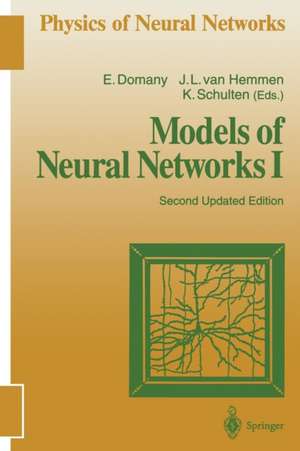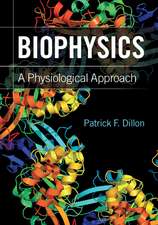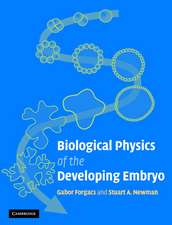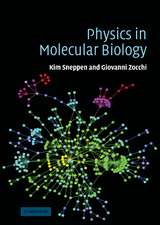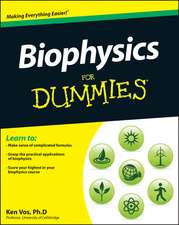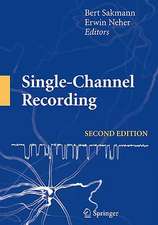Models of Neural Networks I: Physics of Neural Networks
Editat de Eytan Domany, J. Leo van Hemmen, Klaus Schultenen Limba Engleză Paperback – 19 ian 2012
Preț: 393.13 lei
Nou
Puncte Express: 590
Preț estimativ în valută:
75.23€ • 78.74$ • 62.61£
75.23€ • 78.74$ • 62.61£
Carte tipărită la comandă
Livrare economică 31 martie-14 aprilie
Preluare comenzi: 021 569.72.76
Specificații
ISBN-13: 9783642798160
ISBN-10: 3642798160
Pagini: 380
Ilustrații: XVIII, 355 p. 3 illus. in color.
Dimensiuni: 155 x 235 x 20 mm
Greutate: 0.54 kg
Ediția:2nd ed. 1995. Softcover reprint of the original 2nd ed. 1995
Editura: Springer Berlin, Heidelberg
Colecția Springer
Seria Physics of Neural Networks
Locul publicării:Berlin, Heidelberg, Germany
ISBN-10: 3642798160
Pagini: 380
Ilustrații: XVIII, 355 p. 3 illus. in color.
Dimensiuni: 155 x 235 x 20 mm
Greutate: 0.54 kg
Ediția:2nd ed. 1995. Softcover reprint of the original 2nd ed. 1995
Editura: Springer Berlin, Heidelberg
Colecția Springer
Seria Physics of Neural Networks
Locul publicării:Berlin, Heidelberg, Germany
Public țintă
ResearchCuprins
1. Collective Phenomena in Neural Networks.- 1.1 Introduction and Overview.- 1.2 Prerequisites.- 1.3 The Hopfield Model.- 1.4 Nonlinear Neural Networks.- 1.5 Learning, Unlearning, and Forgetting.- 1.6 Hierarchically Structured Information.- 1.7 Outlook.- References.- 2. Information from Structure: A Sketch of Neuroanatomy.- 2.1 Development of the Brain.- 2.2 Neuroanatomy Related to Information Handling in the Brain.- 2.3 The Idea of Electronic Circuitry.- 2.4 The Projection from the Compound Eye onto the First Ganglion (Lamina) of the Fly.- 2.5 Statistical Wiring.- 2.6 Symmetry of Neural Nets.- 2.7 The Cerebellum.- 2.8 Variations in Size of the Elements.- 2.9 The Cerebral Cortex.- 2.10 Inborn Knowledge.- References.- 3. Storage Capacity and Learning in Ising-Spin Neural Networks.- 3.1 Introduction.- 3.2 Content-addressability: A Dynamics Problem.- 3.3 Learning.- 3.4 Discussion.- References.- 4. Dynamics of Learning.- 4.1 Introduction.- 4.2 Definition of Supervised Learning.- 4.3 Adaline Learning.- 4.4 Perceptron Learning.- 4.5 Binary Synapses.- 4.6 Basins of Attraction.- 4.7 Forgetting.- 4.8 Outlook.- References.- 5. Hierarchical Organization of Memory.- 5.1 Introduction.- 5.2 Models: The Problem.- 5.3 A Toy Problem: Patterns with Low Activity.- 5.4 Models with Hierarchically Structured Information.- 5.5 Extensions.- 5.6 The Enhancement of Storage Capacity: Multineuron Interactions.- 5.7 Conclusion.- References.- 6. Asymmetrically Diluted Neural Networks.- 6.1 Introduction.- 6.2 Solvability and Retrieval Properties.- 6.3 Exact Solution with Dynamic Functionals.- 6.4 Extensions and Related Work.- Appendix A.- Appendix B.- Appendix C.- References.- 7. Temporal Association.- 7.1 Introduction.- 7.2 Fast Synaptic Plasticity.- 7.3 Noise-Driven Sequences of Biased Patterns.- 7.4 Stabilizing Sequences by Delays.- 7.5 Applications: Sequence Recognition, Counting, and the Generation of Complex Sequences.- 7.6 Hebbian Learning with Delays.- 7.7 Epilogue.- References.- 8. Self-organizing Maps and Adaptive Filters.- 8.1 Introduction.- 8.2 Self-organizing Maps and Optimal Representation of Data.- 8.3 Learning Dynamics in the Vicinity of a Stationary State.- 8.4 Relation to Brain Modeling.- 8.5 Formation of a “Somatotopic Map”.- 8.6 Adaptive Orientation and Spatial Frequency Filters.- 8.7 Conclusion.- References.- 9. Layered Neural Networks.- 9.1 Introduction.- 9.2 Dynamics of Feed-Forward Networks.- 9.3 Unsupervised Learning in Layered Networks.- 9.4 Supervised Learning in Layered Networks.- 9.5 Summary and Discussion.- References.- Elizabeth Gardner-An Appreciation.
Textul de pe ultima copertă
This collection of articles responds to the urgent need for timely and comprehensive reviews in a multidisciplinary, rapidly developing field of research. The book starts out with an extensive introduction to the ideas used in the subsequent chapters, which are all centered around the theme of collective phenomena in neural netwerks: dynamics and storage capacity of networks of formal neurons with symmetric or asymmetric couplings, learning algorithms, temporal association, structured data (software), and structured nets (hardware). The style and level of this book make it particularly useful for advanced students and researchers looking for an accessible survey of today's theory of neural networks.
